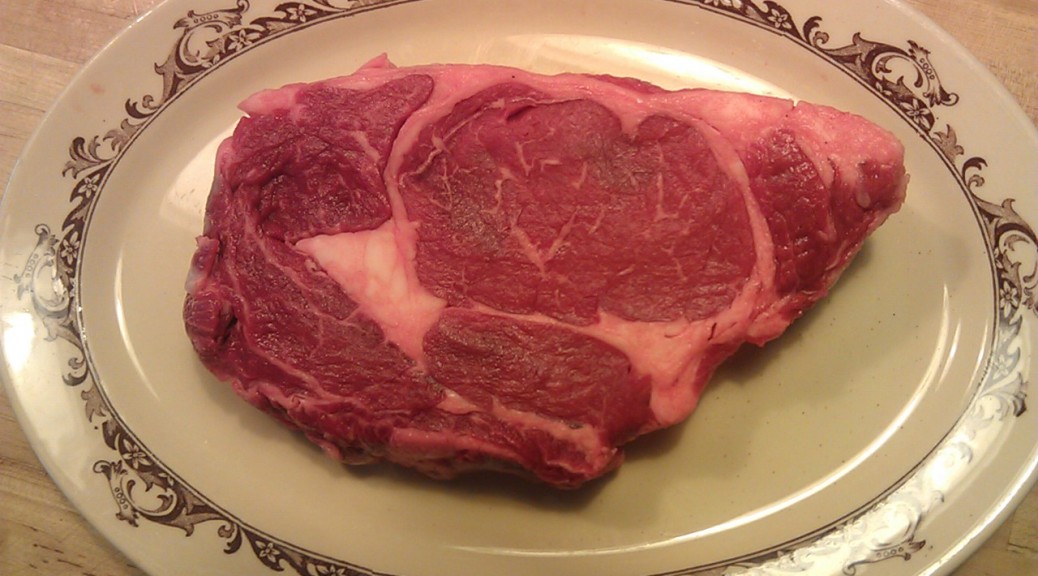BUYING BEEF
Like the three C’s of buying a diamond (Carat, Cut, and Clarity), buying a side of beef is all about weight, cut, and quality.
Weight – The weights that are important to you as a customer are hanging weight and finished weight. Hanging weight is the weight of the carcass after the head, hide, organs have been removed – basically how it looks hanging in the butcher’s meat locker. The amount you pay for a side of beef is based on this weight. We can sell you a whole or half (see the FAQ if you want lees than a half) of a cow at a price/lb of hanging weight. The butcher charges for cut and wrap based on a price/lb of hanging beef plus a percentage of the butcher (harvest) fee based on your share of the cow. The price you end up paying is based on the combination of these 3 fees plus sales tax where applicable.
Cut – So, lets say you bought half a cow (a side of beef), what do you get in your 225-250 lbs of packaged beef? It really depends on what you want (see Cuts, Cuts, and more Cuts), but you can expect approximately what is shown in the adjoining table:
Quality – Many of the factors that impact the quality of the beef as you receive it from the butcher are outside your control (type of beef, beef management, etc.). However, there are choices you can make that affect quality.
- 1. Aging Beef – The typical duration is 7 to 21 days. The longer you age beef, the more flavorful and tender it becomes. However, after a certain point, off-flavors develop and the beef can dry-out. We typically age our beef 17 days but this depends on the cow being butchered.
- 2. Cut – (see Cuts, Cuts, and more Cuts) Our health conscious society has chosen to eat leaner meat (more fat trimmed off) rather than eat smaller portion of more flavorful meat. Some of the best flavors in beef are found in the bones and the fat surrounding the meat that are typically cut away in the butchering process. If you want more flavor, tell the butcher to leave the bone in some of your cuts and trim less fat (you can always trim more yourself). Also, have the butcher package up some of the bones for soup stock and fat for making suet for the birds in the winter.
- 3. Storage – Once you get you beef home, proper storage is the key. You’ll probably be eating this beef over the next year. If you want it to be good tasting at the end of this period, you must protect the meat from freezer burn and that means you should not store the meat in a frost-free freezer! Rather, it should be stored in a deep freeze. If you don’t have one, get a small one, they’re inexpensive to buy and operate. If you don’t want to do that, you have two options: a) find a local commercial meat locker to store your beef, or b) go together with friends when you buy a side of beef so you only end up with a six month supply. (Let us know and we may be able to arrange to have a side of beef available every six months.)
TYPICAL CUTS/QUANTITY IN A SIDE (HALF) OF BEEF
| Filet Mignon | 7 lbs | 14 steaks @ 8 oz |
| New York Steak | 12 lbs | 16 steaks @ 12 oz |
| Sirloin Steak | 11 lbs | 8 steaks @ 22 oz |
| Sirloin Tip roast | 9 lbs | 2 roasts @ 4.5 lbs |
| Top Round steak | 14 lbs | 10 steaks @ 1.4 lbs |
| Flat Iron steak | 4 lbs | 6 steaks @ 0.7 lbs |
| Tri-Tip | 3 lbs | 1 roast @ 3 lbs |
| Rib steaks | 20 lbs | 16 steaks @ 20 oz |
| Chuck roast | 24 lbs | 8 roasts @ 3 lbs |
| Cross rib roast | 8 lbs | 2 roasts @ 4 lbs |
| Brisket | 7 lbs | 2 roasts @ 3.5 lbs |
| Short ribs | 10 lbs | 2 packs @ 5 lbs |
| Stew meat | 16 lbs | 8 packs @ 2 lbs |
| Burger | 80 lbs | 50 packs @ 1.6 lbs |
| Most cuts are boneless with 1/8″ trim. Cut yield is approximate and varies from animal to animal. | ||
CUTS, CUTS, AND MORE CUTS
Without getting into a discussion about primal cuts, almost all cuts of beef come from the front quarter or the rear quarter. The list below contains typical cuts our butcher, Tom, produces. Many cuts are mutually exclusive. We have created an order form to guide you through the butchering process.
| Front Quarter Cuts | Rear Quarter Cuts |
| Rib Eye steak | T-Bone steak |
| Rib steak | New York steak |
| Rib roast | Sirloin steak |
| Chuck roast | Filet Mignon |
| Chuck steak | Tenderloin |
| Brisket | Petite sirloin steak |
| Flat Iron steak | Sirloin Tip roast |
| Skirt steak | Round/cube steak |
| Short ribs | Rump roast |
| Stew meat | Flank steak |
| Cross Rib roast | Eye of round roast |
| Burger | Tri-Tip |
| Burger |
